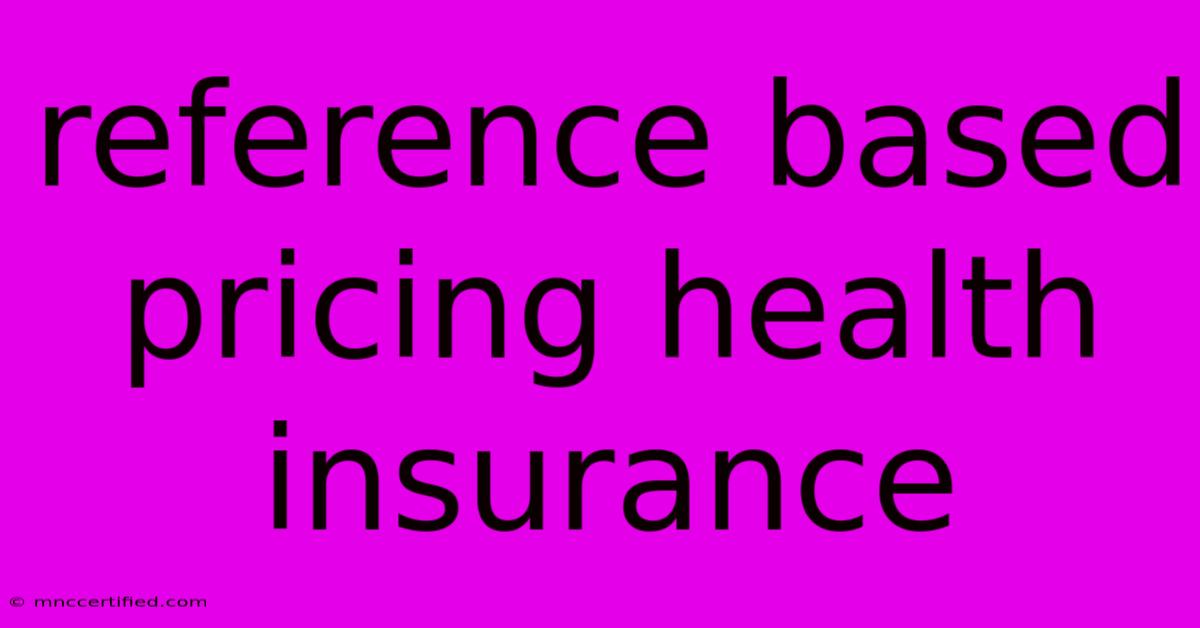Reference Based Pricing Health Insurance

Table of Contents
Reference-Based Pricing: A New Approach to Healthcare Costs
The high cost of healthcare is a pressing issue for many Americans. Rising premiums, deductibles, and out-of-pocket expenses are making it increasingly difficult to afford the care they need. In this environment, reference-based pricing (RBP) has emerged as a potential solution, offering a way to reduce healthcare costs and empower patients to make more informed decisions about their care.
What is Reference-Based Pricing?
Reference-based pricing is a healthcare payment model where patients pay a set amount for medical services based on a predetermined reference point, such as a fair market value or a negotiated rate with healthcare providers. This reference point is often lower than the usual, customary, and reasonable (UCR) rates charged by providers and insurance companies.
Here's how it works:
- Choose a reference point: This could be a national average, a regional average, or a specific negotiated rate with a preferred provider network (PPO).
- Negotiate with providers: Patients or their employers can negotiate directly with providers to accept the reference price for services.
- Pay directly: Patients pay the negotiated price directly to the provider, with no involvement from an insurance company.
- Transparency and control: This approach provides greater transparency into pricing and gives patients more control over their healthcare expenses.
Benefits of Reference-Based Pricing
RBP offers a range of potential benefits, including:
- Lower costs: By circumventing traditional insurance networks and negotiated rates, RBP can significantly reduce the cost of medical services.
- Greater choice and control: Patients are empowered to choose their providers and negotiate prices directly, leading to greater flexibility and autonomy.
- Reduced administrative burden: RBP eliminates the need for complex insurance plans and claims processing, simplifying the healthcare experience.
- Increased transparency: Patients can easily understand the cost of their care, eliminating surprise bills and hidden fees.
Drawbacks of Reference-Based Pricing
While RBP has its advantages, it also presents challenges:
- Limited provider network: Not all providers accept RBP, limiting the choices available to patients.
- Potential for higher out-of-pocket expenses: While the negotiated price may be lower, patients are still responsible for the entire cost, potentially leading to higher out-of-pocket expenses.
- Administrative complexity: Patients are responsible for negotiating prices and managing payments, which can be time-consuming and complex.
- Limited coverage: RBP may not cover all healthcare expenses, requiring patients to pay additional costs out-of-pocket.
Is Reference-Based Pricing Right for You?
RBP is not a one-size-fits-all solution. It is most suitable for individuals and families who:
- Are willing to take a more active role in managing their healthcare costs.
- Are comfortable negotiating with providers.
- Have a good understanding of their healthcare needs and the costs associated with them.
- Are not afraid to explore alternative healthcare options.
Key Considerations for Implementing Reference-Based Pricing
If you are considering RBP, here are some key factors to consider:
- Research providers: Identify providers in your area who accept RBP and compare their rates.
- Negotiate prices: Be prepared to negotiate with providers to secure the best possible rate.
- Understand your coverage: Determine what services are covered by RBP and what out-of-pocket expenses you may incur.
- Explore alternatives: Consider other healthcare cost-saving strategies, such as using telehealth services or seeking care at lower-cost clinics.
Conclusion
Reference-based pricing offers a potential solution to the high cost of healthcare, but it is not without its drawbacks. By understanding the benefits and challenges of RBP and carefully considering your individual needs, you can determine if it is the right option for you.

Thank you for visiting our website wich cover about Reference Based Pricing Health Insurance. We hope the information provided has been useful to you. Feel free to contact us if you have any questions or need further assistance. See you next time and dont miss to bookmark.
Featured Posts
-
Is Emergency Dental Covered By Insurance
Nov 08, 2024
-
Aclu Prepares To Fight Trump Policies
Nov 08, 2024
-
Interest Rate Cut Trump Elections Role
Nov 08, 2024
-
Shock As Robins Exits Coventry City
Nov 08, 2024
-
Can Elections Fix Germanys Stalemate
Nov 08, 2024